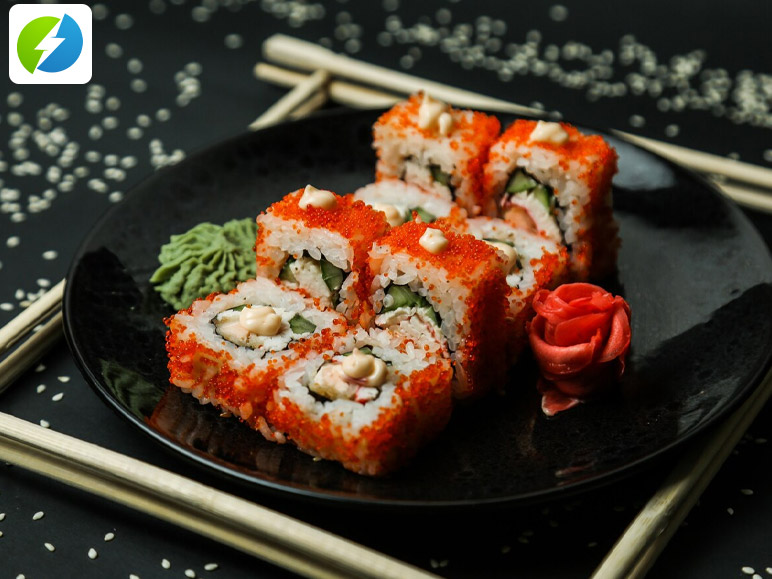Masago and Tobiko are both a form of fish eggs that are often used interchangeably in Japanese cuisine. They come from separate species of fish and have subtle differences in their texture, size, color, and more.
In this article, I will be discussing both Masago and Tobiko and explaining their differences.
Keep reading till the end of the article to find out more information about the same!
About Tobiko

Tobiko is a Japanese term that refers to eggs that are harvested in the form of flying fish. They appear as a form of garnish on the outside of sushi rolls. There are a lot of home cooks and restaurants who serve it as a key ingredient, by wrapping nori on top of a bed for sushi rice.
It is also sometimes served as an accent for donburi or sashimi.
About Masago

What is Masago? Well, Masago is another Japanese term which stands for roe that’s smelt, which primarily the fishers harvest from the members of the family of Osmeridae, like the capelin fish.
In the country of Japan, Masago eggs frequently come from Shishamo which is a smelt species that’s native to the Hokkaido island.
Just like Tobiko (which I discussed earlier), chefs make use of Masago for garnishing California rolls, Masago sushi, and other forms of Rice dishes.
Tip: Masago sauce is really popular and is often eaten with loads of Japanese delectables and dishes.
Key Differences Between Tobiko And Masago

Here is a list of some of the major differences between the two types of fish roe – Masago and Tobiko:
1. Fish Species
Masago and Tobiko are both different kinds of fish. The former is a roe of smelt, while the latter is a flying fish roe.
2. Size
Tobiko is a bit larger in size than that of Masago. The difference is more noticeable when both of them are presented side by side.
3. Texture
Tobiko is known to have a texture that is crunchy and provides a very satisfying pop sound – just like caviar. Whereas, Masago has a softer texture.
4. Color
The color of Tobiko is golden naturally, whereas Masago has a more pale – yellowish color. However, it is also to be said that the producers frequently dye and flavor ingredients in a wide range of colors – green, bright orange, black, or even green.
The producers might also dye and then flavor the yellow-colored fish eggs with citrus fruits or yuzu.
5. Price
Both Tobiko and Masago are affordable but the latter is less expensive than the former. You are going to be able to purchase both Tobiko and Masago in a majority of the grocery stores.
Tip: If you missed out on my answer to “What is masago in sushi” then you can go back to give it a read.
Nutritional Information

Now that we are done covering the part about “Tobiko vs Masago”, let’s move on with the dietary information regarding it.
Tobiko and Masago are both very nutrient-rich in nature. Also to add they are both low in carbs and calories as well. Both of them are absolutely loaded with healthy fats like omega-3, minerals, and proteins. They are rich in vitamins as well, especially Vitamin B-12, Vitamin E, and Vitamin C.
The major flipside of both of these fish eggs is the presence of high levels of sodium in them.
Also Read :
Other Types Of Fish Roe That Are Used For Sushi

Salmon Roe or Ikura is a very popular type of fish egg that is used in preparing dishes for a lot of sushi restaurants. It is much pricier than that of Masago or Tobiko.
Ikura has a much softer texture than that of Tobiko. It also has a very gooey kind of interior which is not the case with both Masago and Tobiko.
There are a lot of different varieties of Salmon and in turn, their eggs also have a variety of different flavors/sizes. A majority of Ikura which are available on the market come from the species Chum Salmon.
Frequently Asked Questions

Here is a list of some of the more frequently asked questions related to the topic:
Q. What Is Another Name For Masago?
A: Masago is also known as Smelt Roe. They are the edible eggs of the fish species Capelin. These fishes belong to the Smelt family. They are also considered to be forage fishes – this just indicates that they are a much more crucial source of food for larger predators like seabirds, whales, codfish, and seals.
Q. Does Masago Expire?
A: The shelf life of Masago is six months when frozen. If they are refrigerated then they can be best stored for about 3-4 days.
Q. Which Fish Egg Is The Most Costly?
A: Beluga Caviar is the most expensive type of caviar. Its market prices range from $7,000 – $22,000.
Q. How Does Masago Exactly Taste Like?
A: Masago has a slightly salty taste and also a sweet flavor which is frequently described to be a bit briny, fishy, bitter, and citrusy. Just because it has such a mild form of flavor, it is more commonly paired with other ingredients like ginger, squid ink, wasabi, or even soy sauce.
Q. What Is The Color Of Caviar?
A: The color of caviars varies from black to brown to gray. Sometimes they are also golden in color.
To Wrap It Up!

If you have never had Masago or even Tobiko before then make sure to give them a try as there are a lot of recipes for being able to enjoy them both in your food.
Thank you for reading up till the end of the article. I hope you found the given information about “Tobiko and Masago” useful.
Must Read :
- 4 Couple Tattoos For Women
- Top 5 Flower Tattoos For Men
- Top 4 Types Of Makeup Looks
- 5 Forearm Tattoos For Women
- 5 Effective Blackhead Removal Tips





